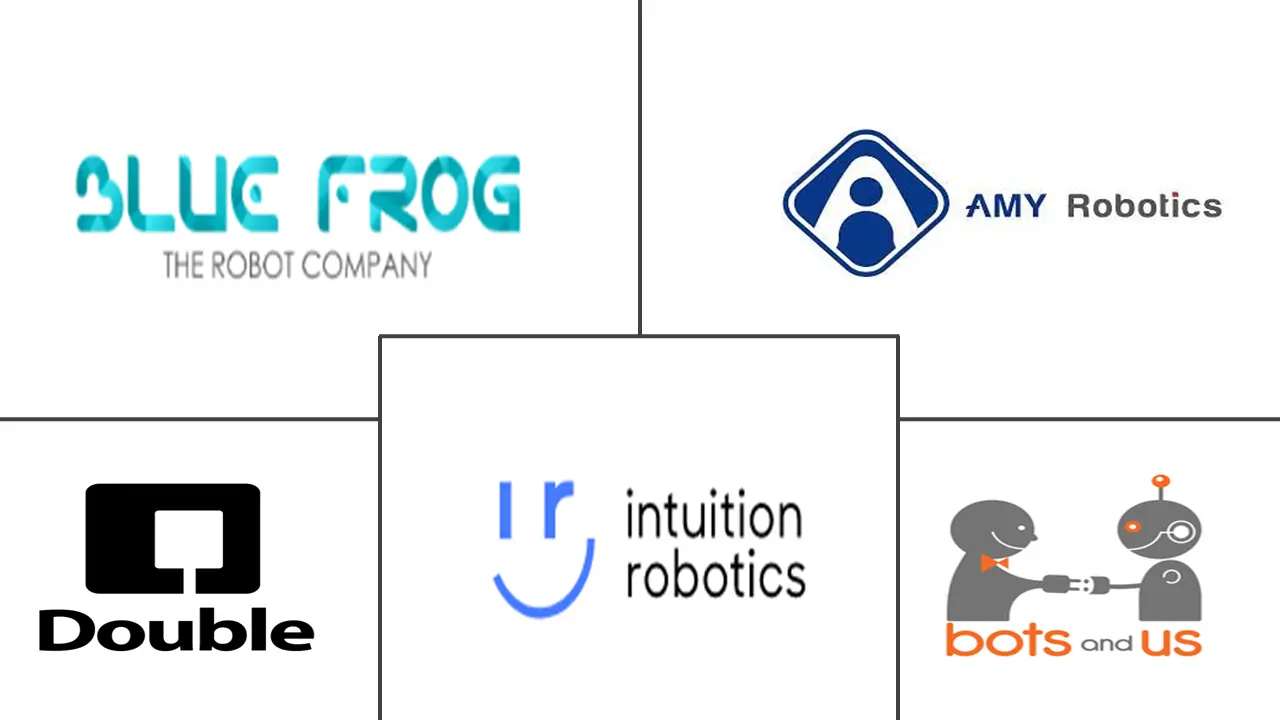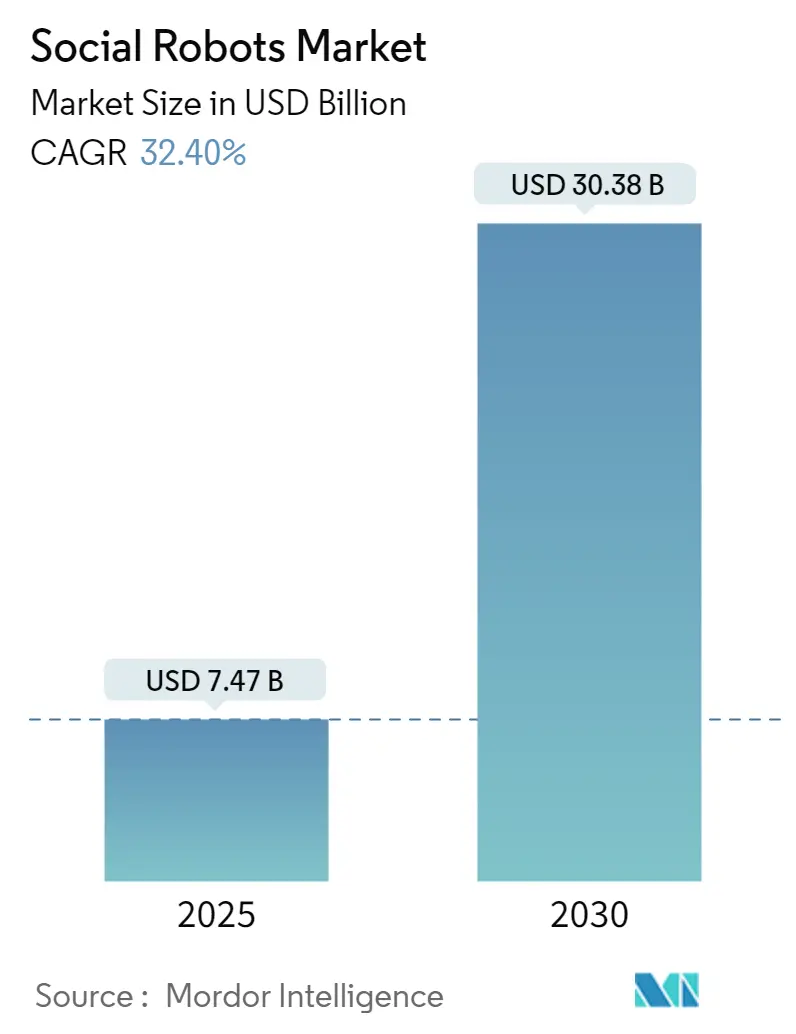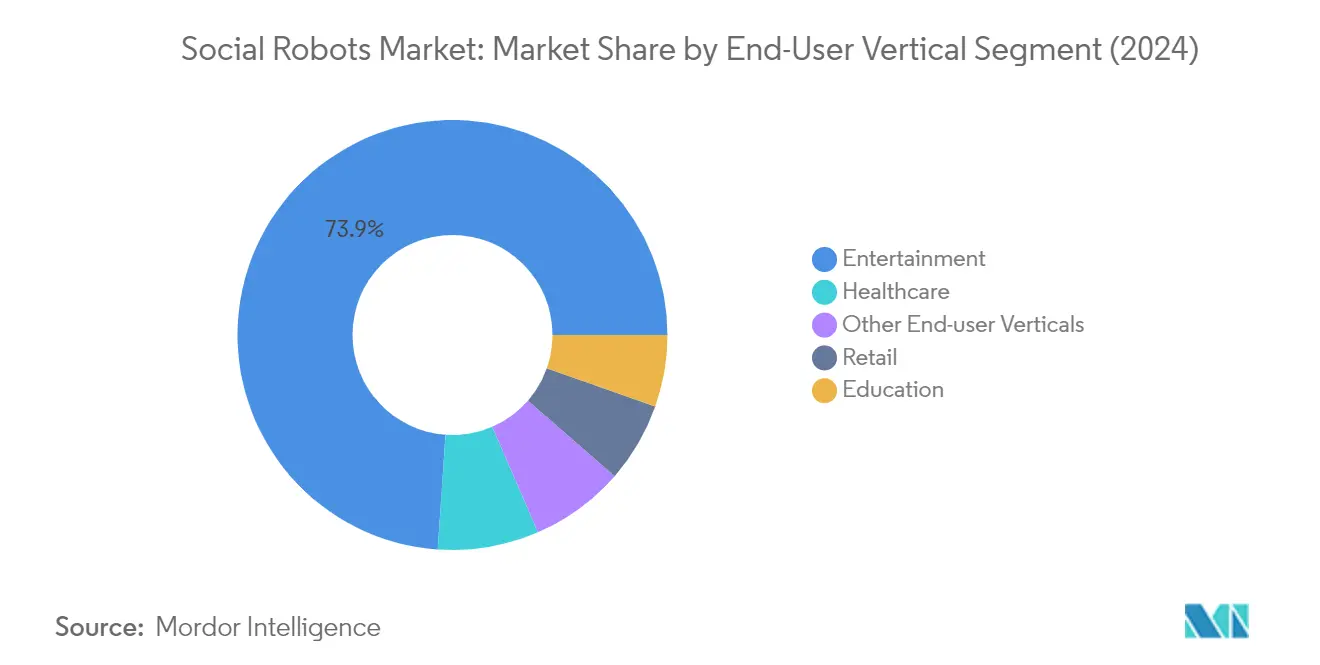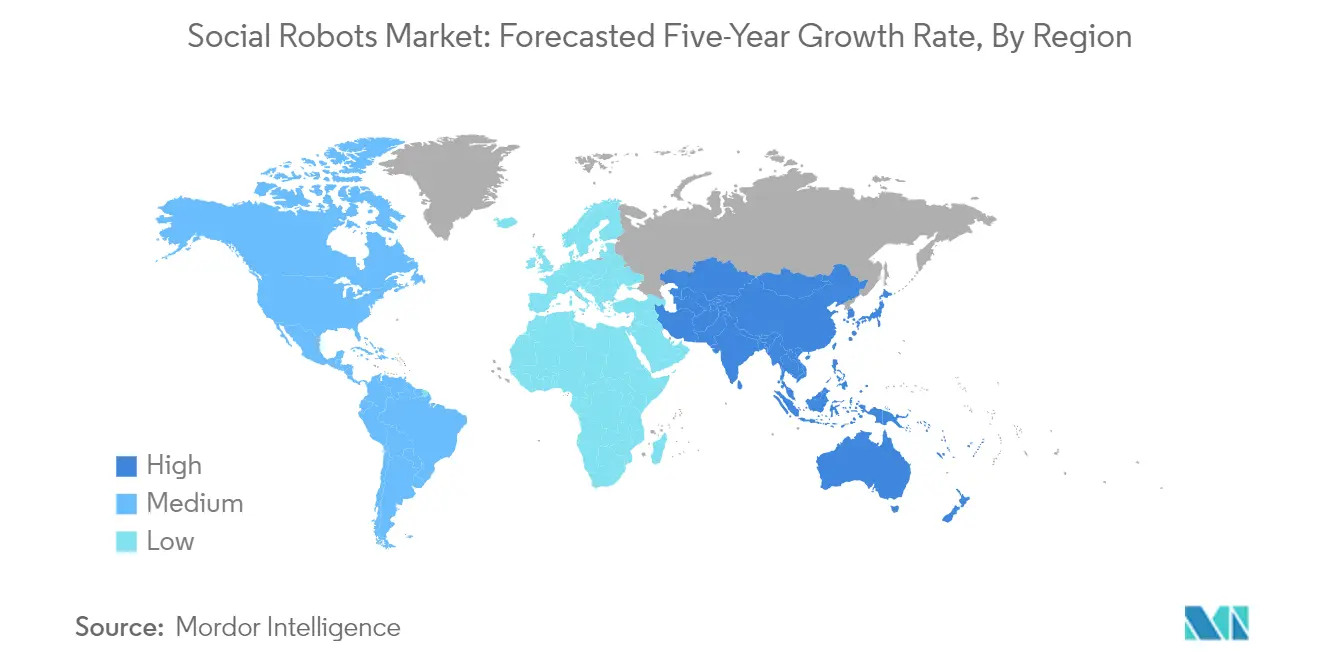Social Robots Market Analysis
The Social Robots Market size is estimated at USD 7.47 billion in 2025, and is expected to reach USD 30.38 billion by 2030, at a CAGR of 32.4% during the forecast period (2025-2030).
The social robotics industry is experiencing transformative growth driven by technological advancements in artificial intelligence, sensors, and actuator technologies. These improvements have enabled more natural human-robot interactions through facial expressions, eye contact, and conversational capabilities. The integration of sophisticated AI algorithms allows robots to recognize faces, emotions, and voices while interpreting speech patterns to respond appropriately to human needs. According to recent projections from the World Bank, approximately 22% of the world's population will be over 60 years old in the coming years, creating an unprecedented demand for assistive technologies and social robots companionship solutions.
The healthcare sector has emerged as a crucial application area for social robots, particularly in elderly care and therapeutic applications. Japan, facing significant demographic challenges, has announced plans to invest approximately JPY 30 trillion (225 billion USD) in various research and development programs over the next five years, with a substantial focus on interactive robots to support its aging population. These social robots in healthcare are being deployed in various healthcare settings, from rehabilitation centers to nursing homes, where they assist in patient care, monitoring, and providing emotional support to residents.
The education sector is witnessing innovative applications of social robots, with institutions increasingly adopting these technologies to enhance learning experiences and support students with special needs. Recent developments in 2023 have seen the emergence of more sophisticated educational robots capable of teaching multiple subjects, including languages, mathematics, and social skills. These robots are particularly effective in providing personalized learning experiences and supporting students with autism and other developmental challenges, demonstrating significant improvements in student engagement and learning outcomes.
The retail and customer service sectors are rapidly integrating social robots to enhance customer experiences and streamline operations. Industry data indicates that 35.80% of organizations have adopted robots for customer experience applications, reflecting the growing acceptance of these technologies in consumer-facing roles. Recent implementations in 2023 have shown successful deployments in shopping malls, hotels, and public spaces, where robots assist with customer navigation, product information, and basic customer service tasks. These applications demonstrate the versatility of social robots in commercial settings and their potential to transform traditional customer service models.
Social Robots Market Trends
Availability of Innovation Budgets and Subsidies to Drive the Adoption
Government funding and research subsidies are playing a crucial role in accelerating the development and adoption of social robots across various sectors. Japan has announced plans to invest approximately JPY 30 trillion (225 billion USD) in research and development programs over the next five years, with a significant portion dedicated to interactive robots development for addressing the needs of their aging population. This substantial commitment demonstrates how national innovation budgets are directly contributing to advancing social robotics technology. In another significant development, researchers at the University of New Hampshire received a five-year grant totaling USD 2.8 million from the National Institutes of Health in 2022 to develop and test companion robots for supporting Alzheimer's patients in home care settings.
The availability of innovation funding is particularly evident in the healthcare sector, where governments and institutions are allocating substantial resources to develop sophisticated social robots for patient care and rehabilitation. These robots are being designed with advanced features such as medication reminder systems, vital sign monitoring capabilities, and interactive communication functions to support both patients and caregivers. The funding support extends beyond direct financial grants to include regulatory frameworks and standardization efforts, as exemplified by Japan's initiative to establish international standards for human-assisting robots through consultation with the International Standards Organization (ISO). This comprehensive approach to innovation funding, combining direct subsidies with supportive regulatory frameworks, is creating a conducive environment for the continued growth of the robotics market in the personal and homecare sector.
High Average Wages Encouraging Business Leaders to Opt for Automation
Rising labor costs and persistent workforce shortages across multiple sectors are compelling business leaders to increasingly turn to automation solutions, particularly social robots. According to the World Health Organization, neurological disorders are projected to increase to 103 million by 2030, representing a 12% increase, which is creating additional pressure on healthcare systems already struggling with staffing shortages. This growing healthcare burden, combined with high wages for specialized care workers, is making automated solutions more economically viable for healthcare providers. The situation is particularly acute in elderly care, where, according to the United States Census Bureau, the share of the old-age population is expected to reach 22% in the coming years, while Canada projects its senior population to exceed 9.5 million, representing 23% of Canadians.
The education sector is also experiencing similar trends, where high wages and staffing challenges are driving the adoption of social robots as teaching assistants and tutoring aids. This is evidenced by the growing implementation of educational robots across American schools, with companies like Van Robotics deploying their tutoring robots across 30 states. These robots provide personalized instruction and maintain student engagement through interactive features, effectively complementing human teachers while helping institutions manage their operational costs. The automation trend is further supported by the retail sector, where businesses are implementing social robotics for customer service and operational tasks, allowing them to optimize their workforce allocation while maintaining service quality. This shift toward automation is particularly pronounced in regions with high labor costs, where the return on investment for robotic solutions becomes more attractive compared to traditional staffing models, further driving the robotics market in the personal and homecare sector.
Segment Analysis: By End-User Vertical
Entertainment Segment in Social Robots Market
The entertainment segment dominates the social robots market, commanding approximately 74% market share in 2024. This is primarily driven by the increasing adoption of interactive robots in the form of robotic toys and companion robots for personal leisure and emotional engagement. The segment's strong performance is attributed to the growing consumer acceptance of social robots that can interact with humans, particularly in Asian markets where manufacturers are continuously innovating their product offerings. The segment's dominance is further strengthened by strategic partnerships between robot manufacturers and entertainment companies, leading to the development of themed robot toys and interactive companions that offer enhanced features such as voice commands, smartphone connectivity, and artificial intelligence capabilities.
Healthcare Segment in Social Robots Market
The healthcare segment is emerging as the fastest-growing vertical in the social robots market, with an expected growth rate of approximately 42% during 2024-2029. This remarkable growth is driven by the increasing adoption of social robots in healthcare facilities for patient assistance, rehabilitation, and emotional support. The segment's expansion is further fueled by the growing need for automated solutions in elderly care, particularly in regions with aging populations. Healthcare providers are increasingly recognizing the value of social robots in reducing staff workload, providing companionship to patients, and assisting in rehabilitation exercises, while also helping maintain social connections between patients and their families through telepresence capabilities.
Remaining Segments in End-User Vertical
The education, retail, and other end-user verticals collectively represent significant opportunities in the social robots market. The education segment is witnessing increased adoption of companion robots for interactive learning and special needs education, while the retail segment is leveraging these robots for customer service and engagement in shopping environments. Other end-user verticals, including public spaces like airports and museums, are implementing social robots for information dissemination and visitor assistance. These segments are benefiting from technological advancements in AI and human-robot interaction capabilities, making social robots more versatile and applicable across various use cases.
Social Robots Market Geography Segment Analysis
Social Robots Market in North America
The North American social robots market maintains a strong position globally, holding approximately 29% of the market share in 2024. The region's leadership is driven by extensive adoption of social robots across healthcare, education, and retail sectors, supported by advanced technological infrastructure and robust research capabilities. The market is characterized by significant investments in automation and digitization initiatives, particularly in improving customer experience across various industries. The region's healthcare sector demonstrates particular promise, with growing implementation of companion robots in patient care, rehabilitation, and elderly assistance. Educational institutions across North America are increasingly incorporating interactive robots to enhance learning experiences and provide personalized instruction. The retail sector's digital transformation has created numerous opportunities for social robot deployment in customer service and operational efficiency. The region's strong focus on technological innovation, coupled with high acceptance rates of automated solutions, continues to drive market growth.
Social Robots Market in Europe
The European social robots market has demonstrated remarkable growth, achieving approximately a 28% annual growth rate from 2019 to 2024. The region's market development is fundamentally supported by strong governmental initiatives promoting digitalization and robotics advancement. Europe's robust medical robot manufacturing capabilities and extensive research programs in social robotics have established it as a key innovation hub. The market is particularly driven by the region's aging population dynamics and the increasing need for automated healthcare solutions. European countries are actively investing in research and development of culturally adaptive care robots, focusing on enhancing human-robot interaction capabilities. The region's commitment to digital transformation across industries, particularly in the healthcare and education sectors, continues to create new opportunities for social robot deployment. The market benefits from strong collaboration between academic institutions, research centers, and industrial partners, fostering continuous innovation in social robotics technology.
Social Robots Market in Asia-Pacific
The Asia-Pacific region represents the most dynamic market for social robots, with projections indicating approximately a 36% growth rate from 2024 to 2029. The region's market is characterized by the presence of major social robot manufacturers and significant technological advancement initiatives. Countries like Japan, South Korea, and China are at the forefront of social robotics innovation, driven by their strong manufacturing capabilities and technological expertise. The market benefits from substantial government support through various initiatives promoting automation and artificial intelligence development. The region's rapid urbanization and increasing adoption of advanced technologies across various sectors create fertile ground for social robot deployment. Healthcare and elderly care applications are particularly prominent, addressing the region's demographic challenges. The education sector shows strong potential for growth, with increasing implementation of robotic solutions in learning environments. The retail sector's digital transformation and the growing acceptance of automated customer service solutions further drive market expansion.
Social Robots Market in Rest of the World
The Rest of the World market, encompassing Latin America and the Middle East and Africa, demonstrates emerging potential in the social robots sector. The region's market is primarily driven by increasing investments in artificial intelligence and robotics, particularly in the Gulf Cooperation Council (GCC) countries. Strategic initiatives such as Saudi Vision 2030 and the UAE AI Strategy are creating favorable conditions for social robot adoption. The retail sector, particularly in the UAE and Saudi Arabia, shows significant interest in implementing social robots for customer service and engagement. Latin American countries are gradually embracing social robotics technology, particularly in the education and healthcare sectors. The region's growing focus on digital transformation and automation in public spaces, including shopping malls and educational institutions, presents substantial opportunities for market expansion. The increasing awareness of social robots' benefits in enhancing customer experience and operational efficiency continues to drive adoption across various sectors.
Social Robots Industry Overview
Top Companies in Social Robots Market
The social robots market features established players like Blue Frog Robotics, Hanson Robotics, and SoftBank Robotics alongside emerging innovators such as Embodied Inc. and OhmniLabs. Social robotics companies are heavily investing in research and development to enhance their robots' interactive capabilities, emotional intelligence, and application-specific functionalities. Strategic partnerships with healthcare providers, educational institutions, and retail chains have become increasingly common as companies seek to expand their market presence. Product innovation focuses on developing more sophisticated AI algorithms, improved sensor technologies, and enhanced human-robot interaction capabilities. Operational agility is demonstrated through modular robot designs that can be customized for different use cases, while geographic expansion is pursued through distributor networks and local partnerships in key markets.
Dynamic Market with Diverse Player Profiles
The social robots market exhibits a moderately fragmented structure with a healthy mix of global technology conglomerates and specialized robotics firms. Market players range from well-funded startups focusing on specific applications like healthcare or education to established companies with diverse product portfolios. The competitive landscape is characterized by continuous technological advancement and innovation, with companies often maintaining their own proprietary software platforms and hardware designs. Mergers and acquisitions activity is primarily driven by larger companies seeking to acquire innovative technologies or expand into new application areas, while strategic partnerships enable market penetration and technology sharing.
The market demonstrates strong regional variations in competitive dynamics, with different players dominating specific geographical markets based on local requirements and regulations. Companies are increasingly adopting a collaborative approach, forming partnerships with academic institutions and research organizations to advance their technological capabilities. The industry is witnessing a gradual shift from product-based revenue models to subscription and service-based approaches, particularly in healthcare and education sectors. Market consolidation is primarily observed in mature segments, while emerging applications continue to attract new entrants with innovative solutions.
Innovation and Adaptability Drive Market Success
Success in the social robotics market increasingly depends on companies' ability to develop solutions that address specific end-user needs while maintaining cost-effectiveness and reliability. Market leaders are focusing on building comprehensive ecosystems around their robots, including software platforms, development tools, and support services. The ability to provide customizable solutions while maintaining scalability has become a crucial differentiator. Companies are also investing in building strong distribution networks and after-sales support infrastructure to ensure customer satisfaction and market retention. The risk of substitution remains relatively low due to the unique combination of physical presence and social interaction capabilities offered by these robots.
Future success in the market will largely depend on companies' ability to navigate regulatory requirements, particularly in healthcare and education applications. End-user concentration varies significantly across different application segments, with healthcare and education showing higher concentration levels compared to retail and entertainment. Companies are increasingly focusing on developing robots with enhanced privacy features and security capabilities to address growing concerns about data protection and user safety. The ability to demonstrate clear return on investment and tangible benefits to end-users will become increasingly important as the market matures. Market players must also maintain flexibility in their product development approaches to adapt to rapidly evolving technological capabilities and changing user expectations.
Social Robots Market Leaders
-
Blue Frog Robotics SAS
-
Amy Robotics Co. Ltd
-
Double Robotics Inc.
-
Intuition Robotics Ltd
-
BotsAndUs Ltd
- *Disclaimer: Major Players sorted in no particular order
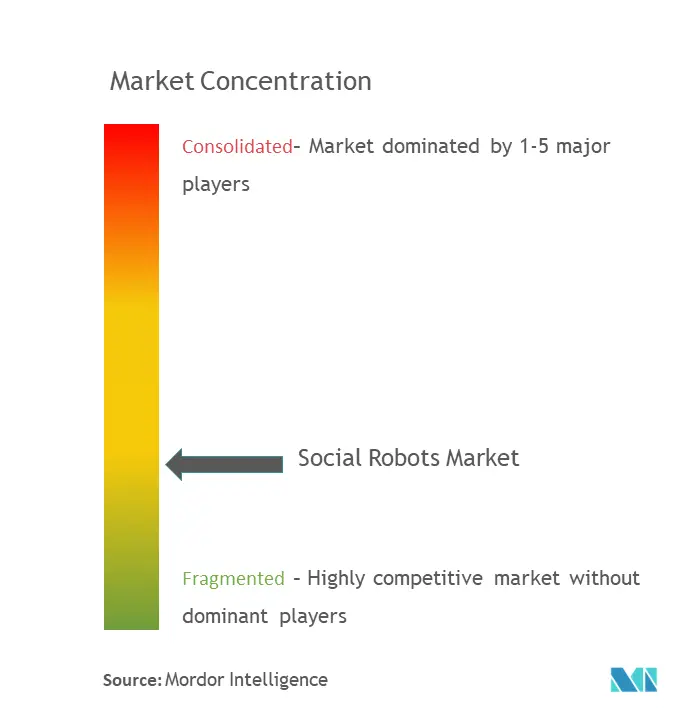
Social Robots Market News
- March 2022: Intuition Robotics Ltd announced the official commercial launch of its ElliQ digital care companion. The social robot is designed to help older adults be more physically active and socially engaged, enabling them to have happier, more independent lives. Intuition Robotics has spent more than five years developing and beta-testing ElliQ with older adults. ElliQ is designed to connect older adults to their families, caregivers, and the outside world through behavioral sciences, combining psychology and advanced cognitive AI capabilities. The robot is designed specifically for the older population living alone. ElliQ has shown it effectively alleviates feelings of loneliness and social isolation.
- March 2022: Scientists from the Faculty of Engineering, Information, and Systems at the University of Tsukuba designed a text message mediation robot to help users control their anger when receiving disheartening news. The robot may help improve social interactions moving toward a world with increasing digital communications. The robot was deployed as a mediator for reading text messages. A text with unwelcome or frustrating news could be followed by an appeal by OMOY not to get upset or even sympathy for the user.
Social Robots Market Report - Table of Contents
1. INTRODUCTION
- 1.1 Study Assumptions and Market Definition
- 1.2 Scope of the Study
2. RESEARCH METHODOLOGY
3. EXECUTIVE SUMMARY
4. MARKET INSIGHTS
- 4.1 Market Overview
-
4.2 Industry Attractiveness - Porter's Five Forces Analysis
- 4.2.1 Bargaining Power of Suppliers
- 4.2.2 Bargaining Power of Consumers
- 4.2.3 Threat of New Entrants
- 4.2.4 Threat of Substitutes
- 4.2.5 Intensity of Competitive Rivalry
- 4.3 Impact of COVID-19 on the Social Robots Market
5. MARKET DYNAMICS
-
5.1 Market Drivers
- 5.1.1 Availability of Innovation Budgets and Subsidies to Drive the Adoption
- 5.1.2 High Average Wages Encouraging Business Leaders to Opt for Automation
-
5.2 Market Challenges
- 5.2.1 Complexity Pertaining to Algorithmic Bias
- 5.2.2 Concern Related to Long-term Engagement and Unintended Consequences
6. MARKET SEGMENTATION
-
6.1 By End-user Vertical
- 6.1.1 Healthcare
- 6.1.2 Education
- 6.1.3 Entertainment
- 6.1.4 Retail
- 6.1.5 Others End-user Verticals
-
6.2 By Geography
- 6.2.1 North America
- 6.2.2 Europe
- 6.2.3 Asia-Pacific
- 6.2.4 Rest of the World
7. COMPETITIVE LANDSCAPE
-
7.1 Company Profiles
- 7.1.1 Blue Frog Robotics SAS
- 7.1.2 Amy Robotics Co. Ltd
- 7.1.3 Double Robotics Inc.
- 7.1.4 Intuition Robotics Ltd
- 7.1.5 BotsAndUs Ltd
- 7.1.6 AoBo Information Technology Co. Ltd
- 7.1.7 MoviaRobotics Inc.
- 7.1.8 Haapie SAS
- 7.1.9 OhmniLabs Inc.
- 7.1.10 KOMPAI Robotics
- 7.1.11 SZ DJI Technology Co. Ltd
- 7.1.12 Embodied Inc. AB
- 7.1.13 Wonder Workshop Inc.
- 7.1.14 Hanson Robotics Ltd
- 7.1.15 Furhat Robotics AB
- 7.1.16 Bionik Laboratories Corp.
- 7.1.17 AlterG Inc.
- 7.1.18 Motorika USA Inc.
- 7.1.19 Blue Ocean Robotics ApS
- 7.1.20 Matia Robotics (US) Inc.
- 7.1.21 Camanio AB
- 7.1.22 Kinova Inc.
- 7.1.23 Inrobics Social Robotics SLL
- *List Not Exhaustive
8. INVESTMENT ANALYSIS
9. FUTURE OF THE MARKET
Social Robots Industry Segmentation
The social robots market is segmented by End-user Vertical (Healthcare, Education, Entertainment, Retail, and Other End-user Verticals) and by Geography (North America, Europe, Asia-Pacific, and the Rest of the World). The social robots for the market study are defined as interactive and assistive autonomous mobile robots and remote-controlled robots, majorly aimed at uplifting an individual's engagement/societal capabilities.
The study is structured to include social robots types, such as rehabilitation robots (physical and emotional therapy), elderly and handicapped assistive devices and telecare and telepresence robots, guidance, information, and telepresence robots for commercial and public space applications, robot toys that move, dances, roves about or generally interacts with the environment. Education purposes of social robots include both types of robots, which offers a platform for experimenting with the robot technology and facilitate interactive teaching to humans.
The market sizes and forecasts are provided in terms of value (USD million) for all the above segments.
| By End-user Vertical | Healthcare |
| Education | |
| Entertainment | |
| Retail | |
| Others End-user Verticals | |
| By Geography | North America |
| Europe | |
| Asia-Pacific | |
| Rest of the World |
Social Robots Market Research FAQs
How big is the Social Robots Market?
The Social Robots Market size is expected to reach USD 7.47 billion in 2025 and grow at a CAGR of 32.40% to reach USD 30.38 billion by 2030.
What is the current Social Robots Market size?
In 2025, the Social Robots Market size is expected to reach USD 7.47 billion.
Who are the key players in Social Robots Market?
Blue Frog Robotics SAS, Amy Robotics Co. Ltd, Double Robotics Inc., Intuition Robotics Ltd and BotsAndUs Ltd are the major companies operating in the Social Robots Market.
Which is the fastest growing region in Social Robots Market?
North America is estimated to grow at the highest CAGR over the forecast period (2025-2030).
Which region has the biggest share in Social Robots Market?
In 2025, the Asia-Pacific accounts for the largest market share in Social Robots Market.
What years does this Social Robots Market cover, and what was the market size in 2024?
In 2024, the Social Robots Market size was estimated at USD 5.05 billion. The report covers the Social Robots Market historical market size for years: 2019, 2020, 2021, 2022, 2023 and 2024. The report also forecasts the Social Robots Market size for years: 2025, 2026, 2027, 2028, 2029 and 2030.
Our Best Selling Reports
Social Robots Market Research
Mordor Intelligence offers comprehensive expertise in the rapidly evolving social robotics industry. We deliver in-depth analysis of social robots and their applications across various sectors. Our extensive research covers the growing adoption of companion robots and developments in interactive robots. We place particular emphasis on social robots in healthcare applications.
The report provides detailed insights into the robotics market in personal and homecare sector, examining how indoor robots are transforming daily life. Our detailed market analysis, available as an easy-to-download report PDF, offers stakeholders crucial insights into emerging social robotics companies and their innovations.
The research encompasses various segments, including interactive therapy solutions and entertainment applications. It provides valuable data on market dynamics and growth opportunities. The report delivers actionable intelligence for businesses operating in the personal and homecare robotics sector. We focus specifically on how social robots are revolutionizing customer interaction and service delivery across multiple industries.

